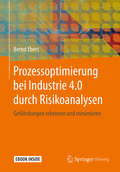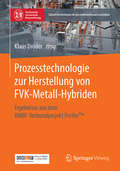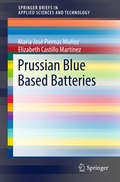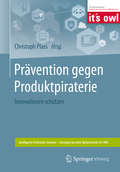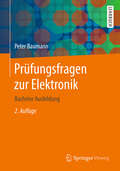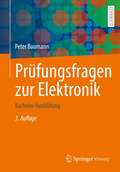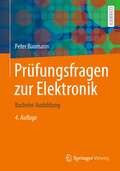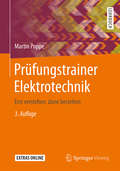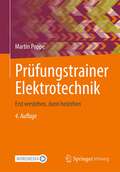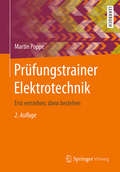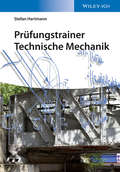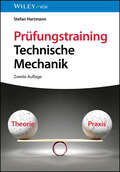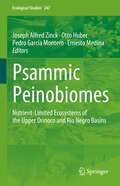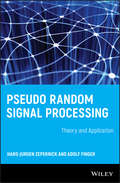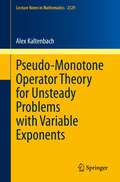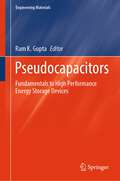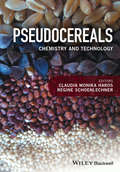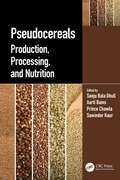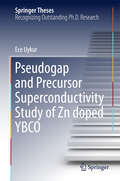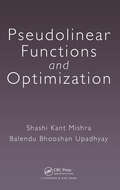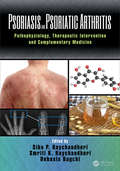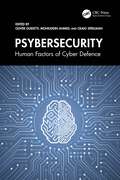- Table View
- List View
Prozessoptimierung bei Industrie 4.0 durch Risikoanalysen: Gefährdungen Erkennen Und Minimieren
by Bernd EbertDas Buch beschreibt die Methodik der Risikoanalyse bei der Umsetzung von Industrie 4.0. Durch diese Methode können strukturelle und Schnittstellen-Probleme in vernetzten Systemen frühzeitig erkannt und geeignete Gegenmaßnahmen getroffen werden. Die theoretischen Ansätze zu Industrie 4.0 werden in 3 Betrachtungs-Ebenen gegliedert. Für jede dieser Ebenen werden die Spezifika beschrieben und mittels Risikoanalyse bewertet. Werden Risiken erkannt, folgen Vorschläge zu deren Minimierung. Neben den exakt definierbaren Stückgut-Prozessen (z.B. im Automotive-Bereich) ist eine Betrachtung z.B. von losen Mengen (wie eingesetzte Chemikalien) erforderlich. Da die Einführung von Industrie 4.0 nicht global schlagartig erfolgen wird, sind die zeitliche Abfolge der Einführung sowie Zwischenstufen bzgl. ihrer Risiken sowie deren Minimierung zu betrachten.Die ZielgruppenDas Buch wendet sich an Planungsingenieure für technische Systeme, MSR-Ingenieure, Softwareplaner, Begutachter für Prozess- und Anlagensicherheit und an Verantwortliche für technische Innovationen.
Prozesstechnologie zur Herstellung von FVK-Metall-Hybriden: Ergebnisse aus dem BMBF-Verbundprojekt ProVorPlus (Zukunftstechnologien für den multifunktionalen Leichtbau)
by Klaus DröderDieses Buch stellt den Abschlussbericht zum Verbundprojekt ProVorPlus vor. ProVorPlus leistet Beiträge zur anwendungsnahen Erforschung und Entwicklung großserientauglicher Fertigungs- und Produktionstechnologien für die wirtschaftliche Herstellung hybrider Leichtbaukomponenten und zum Aufbau von Prozessen zur Erzeugung flächiger Multi-Material-Fahrzeugstrukturen. Darüber hinaus werden Erkenntnisse über neuartige Produktionstechnologien vorgestellt, die zum einen die automatisierte Fertigung komplexer Vorformlinge in Multi-Material-Bauweise und zum anderen die Endkonsolidierung hybrider Bauteile durch die Verkettung von Einzelprozessen ermöglichen. Es wird dargestellt, wie die Technologien zum Abschluss in einer Prozesskette abgebildet und in Form von Anlagentechnik in der Open Hybrid LabFactory umgesetzt wurde.
Prussian Blue Based Batteries (SpringerBriefs in Applied Sciences and Technology)
by María José Piernas Muñoz Elizabeth Castillo MartínezThis book reviews the structure and composition of Prussian Blue materials. It presents the state-of-the-art of their application to metal-ion batteries, highlighting the benefits derived from the integration of electrochemical energy storage with clean energies. It concludes with future perspectives including prototyping and large-scale production.
Prävention gegen Produktpiraterie: Innovationen schützen (Intelligente Technische Systeme – Lösungen aus dem Spitzencluster it’s OWL)
by Christoph PlassIm Rahmen des Spitzenclusters it's OWL sind in den letzten 5 Jahren technisch innovative Lösungen entstanden, die den Unternehmen einen Wettbewerbsvorsprung ermöglichen. Dieses Know-how abzusichern und gegen Plagiatoren zu schützen, ist Gegenstand des Projekts Prävention gegen Produktpiraterie gewesen.Entstanden sind durchgängige Methodenketten zur Erarbeitung von ganzheitlichen Schutzkonzeptionen, die weit über die isolierten Ansätze konstruktiver Gestaltung des Produktes oder Markierungstechniken hinausgehen.Die Autoren zeigen die Systematik auf und belegen anhand von Praxisbeispielen, wie sie anzuwenden ist: Von der Analyse der Bedrohung, über die Festlegung von Schutzmaßnahmen bis hin zur Gestaltung von Bauteilen mit Hilfe moderner additiver Fertigungsverfahren, die Reverse Engineering erschweren.Das Buch zielt auf Praktiker in der Industrie, die sich mit dem Schutz ihrer Produkte befassen.
Prüfungsfragen zur Elektronik: Bachelor Ausbildung
by Peter BaumannDie in diesem Lehrbuch gestellten Prüfungsfragen beziehen sich auf die Funktion verschiedenartiger Halbleiter-Bauelemente als auch auf deren Zusammenwirken in Schaltungen. Die gegebenen Antworten erfolgen zunächst in Form kurz gefasster Erklärungen und werden anschließend mit Gleichungen und insbesondere mit Diagrammen aus PSPICE-Analysen anschaulich vertieft. Die Ausführung dieser Analysen wird nachvollziehbar dokumentiert. Die Prüfungsfragen zielen darauf ab, die jeweiligen Eigenschaften der Bauelemente bzw. Schaltungen schrittweise zu erfassen. Die mit den Prüfungsfragen angesprochenen Dioden, Thyristoren, bipolaren und unipolaren Transistoren, CMOS-Baugruppen sowie Operationsverstärker sind aus der frei zugänglichen Studenten-Version des Netzwerkanalyseprogramms PSPICE aufrufbar. Der nutzbare Schaltungsumfang reicht aus, um wichtige Grundschaltungen der Elektronik aufzubauen und zu analysieren. Die Antworten können daher mit konkreten Angaben versehen werden.
Prüfungsfragen zur Elektronik: Bachelor Ausbildung
by Peter BaumannDie in diesem Lehrbuch gestellten Prüfungsfragen beziehen sich auf die Wirkungsweise von elektronischen Bauelementen und Sensoren auf der Basis von PSPICE-Modellen und deren Anwendung in Schaltungen. Die Antworten werden durch die Angabe von Gleichungen und PSPICE-Analysen anschaulich unterstützt. Die Prüfungsfragen stehen insbesondere in enger Verbindung zum Laborpraktikum.
Prüfungsfragen zur Elektronik: Bachelor Ausbildung
by Peter BaumannDie in diesem Lehrbuch gestellten Prüfungsfragen beziehen sich auf die Wirkungsweise von elektronischen Bauelementen und Sensoren auf der Basis von PSPICE-Modellen und deren Anwendung in Schaltungen. Die Antworten werden durch die Angabe von Gleichungen und die Ausführung von PSPICE-Analysen anschaulich unterstützt. Die Prüfungsfragen stehen in enger Verbindung zum Laborpraktikum.
Prüfungstrainer Elektrotechnik: Erst verstehen, dann bestehen
by Martin PoppeDieses Buch bereitet gezielt auf eine Prüfung vor dem Bachelor-Abschluss vor. Es enthält Antworten auf Prüfungsfragen, Lösungsstrategien für Klausuraufgaben und Begründungen der wesentlichen Gesetze der Elektrotechnik und Elektronik. Die Fragen sind nach Schwierigkeitsgrad geordnet. So können die Studierenden Lücken im eigenen Wissen finden und durch ein vertieftes Verständnis ersetzen. Über 300 Abbildungen helfen dem Verständnis und vollständig durchgerechnete aktuelle Praxisbeispiele veranschaulichen den Stoff.Die 3. Auflage wurde aktualisiert, vollständig überarbeitet und enthält nun zusätzlich zu den mehr als 200 Klausuraufgaben 160 neue Fragen aus mündlichen Prüfungen und verständlich begründete Antworten. Das Buch wendet sich an Studierende der Elektrotechnik im Haupt- oder Nebenfach, die sich gezielt auf eine Prüfung vor dem Bachelor-Abschluss vorbereiten wollen.
Prüfungstrainer Elektrotechnik: Erst verstehen, dann bestehen
by Martin PoppeDieses Buch soll helfen, Prüfungen auf dem Gebiet der Elektrotechnik zu bestehen. Die 4. Auflage wurde aktualisiert, vollständig überarbeitet und bietet den Zugang zu mehr als 300 elektronischen Karteikarten („Flash Cards“), mit deren Hilfe die Kenntnis elementarer elektrotechnischer Begriffe und Zusammenhänge gefestigt werden kann. Das Buch enthält 160 Fragen aus mündlichen Prüfungen und verständlich begründete Antworten sowie mehr als 200 nach Schwierigkeitsgrad geordnete Klausuraufgaben. Zu diesen Aufgaben werden ausführliche Lösungen vorgerechnet und Lösungsstrategien vermittelt.Zu jedem der acht Themengebiete werden in einem Theorieteil die grundlegenden Zusammenhänge erläutert. Über 300 Abbildungen helfen dem Verständnis und vollständig durchgerechnete aktuelle Praxisbeispiele veranschaulichen den Stoff.
Prüfungstrainer Elektrotechnik: Erst verstehen, dann bestehen
by Martin PoppeDieses Buch bereitet gezielt auf eine Prüfung vor dem Bachelor-Abschluss vor. Es enthält Antworten auf Prüfungsfragen, Lösungsstrategien für Klausuraufgaben und Begründungen der wesentlichen Gesetze der Elektrotechnik und Elektronik. Das Buch enthält zur Verdeutlichung der Lösungsstrategien mehr als 300 Abbildungen.Für die 2. Auflage neu aufgenommen wurden neben Feldberechnungen mit und ohne Magnetkreise auch diverse Praxisbeispiele und Details zum Verhalten von Leitungen.
Prüfungstrainer Technische Mechanik
by Stefan HartmannMit dem Prufungstrainer zum Lehrbuch "Technische Mechanik" von Stefan Hartmann braucht man nicht mehr vor Klausuren und Prufungen zittern. Mehr als 250 Aufgaben mit ausfuhrlich durchgerechneten Losungen aus allen Themengebieten der Technischen Mechanik - Statik, Elastostatik, Kinematik und Dynamik - helfen beim Verstehen und Vertiefen der Lerninhalte. Unerlasslich fur Studierende in Ingenieurstudiengangen wie Maschinenbau, Verfahrenstechnik und Bauwesen: insbesondere zusammen mit dem Lehrbuch "Technische Mechanik" legt der Prufungstrainer die Grundlagen furs weiterfuhrende Studium.
Prüfungstraining Technische Mechanik
by Stefan HartmannMit „Prüfungstraining Technische Mechanik“ von Stefan Hartmann braucht man vor Klausuren und Prüfungen nicht mehr zu zittern. Mehr als 250 Aufgaben mit ausführlich durchgerechneten Lösungen aus allen Themengebieten der Technischen Mechanik – Statik, Elastostatik, Kinematik und Dynamik – helfen beim Verstehen und Vertiefen der Lerninhalte. Unerlässlich für Studierende in Ingenieurstudiengängen wie Maschinenbau, Verfahrenstechnik und Bauwesen: Insbesondere zusammen mit dem Lehrbuch „Technische Mechanik“ legt das Prüfungstraining die Grundlagen fürs weiterführende Studium.
Psalms For The End Of The World: 'Ingenious and compelling' THE TIMES
by Cole Haddon'Ingenious and compelling' THE TIMES'A book designed to be more than the sum of its parts, and one that achieves that because love is the thing that binds it together. Vitally fresh' DOMINIC NOLANIt's 1962 and physics student Grace Pulansky believes she has met the man of her dreams, Robert Jones, while serving up slices of pecan pie at the local diner. But then the FBI shows up, with their fedoras and off-the-rack business suits, and accuses him of being a bomb-planting mass-murderer.Finding herself on the run with Jones across America's Southwest, the discoveries awaiting Gracie will undermine everything she knows about the universe. Her story will reveal how scores of lives - an identity-swapping rock star, a mourning lover in ancient China, Nazi hunters in pursuit of a terrible secret, a crazed artist in pre-revolutionary France, an astronaut struggling with a turbulent interplanetary future, and many more - are interconnected across space and time by love, grief, and quantum entanglement.Spanning continents, centuries, and dimensions, this exquisitely crafted and madly inventive novel - a triple-disk, concept-album of a book - is a profound yet propulsive enquiry into the nature of reality - the perfect immersive read for fans of David Mitchell, Emily St. John Mandel, Neil Gaiman and Margaret Atwood.'A trans-dimensional, kaleidoscopic mystery-box of a novel.... wholly and riotously original. Haddon is a mad scientist of genre and his epic is a tour de force.' PETER HO DAVIES
Psalms For The End Of The World: 'Ingenious and compelling' THE TIMES
by Cole Haddon'Ingenious and compelling' THE TIMES'A book designed to be more than the sum of its parts, and one that achieves that because love is the thing that binds it together. Vitally fresh' DOMINIC NOLANIt's 1962 and physics student Grace Pulansky believes she has met the man of her dreams, Robert Jones, while serving up slices of pecan pie at the local diner. But then the FBI shows up, with their fedoras and off-the-rack business suits, and accuses him of being a bomb-planting mass-murderer.Finding herself on the run with Jones across America's Southwest, the discoveries awaiting Gracie will undermine everything she knows about the universe. Her story will reveal how scores of lives - an identity-swapping rock star, a mourning lover in ancient China, Nazi hunters in pursuit of a terrible secret, a crazed artist in pre-revolutionary France, an astronaut struggling with a turbulent interplanetary future, and many more - are interconnected across space and time by love, grief, and quantum entanglement.Spanning continents, centuries, and dimensions, this exquisitely crafted and madly inventive novel - a triple-disk, concept-album of a book - is a profound yet propulsive enquiry into the nature of reality - the perfect immersive read for fans of David Mitchell, Emily St. John Mandel, Neil Gaiman and Margaret Atwood.'A trans-dimensional, kaleidoscopic mystery-box of a novel.... wholly and riotously original. Haddon is a mad scientist of genre and his epic is a tour de force.' PETER HO DAVIES
Psammic Peinobiomes: Nutrient-Limited Ecosystems of the Upper Orinoco and Rio Negro Basins (Ecological Studies #247)
by Joseph Alfred Zinck Otto Huber Ernesto Medina Pedro García MonteroThe book represents a multidisciplinary approach to understanding soil–landscape–vegetation relationships and, specifically, the ecophysiology of plant communities developing on sandy soils of very low fertility that are subject to seasonal flooding. It provides an overview of the white sand ecosystems within the Amazon basin, and focuses on the forest and herbaceous (meadows) vegetation growing on the dystrophic sandy soils of the upper Negro and Orinoco river basins. Several chapters describe physiographic aspects of the study area using integrated remote sensing and in situ sampling. By doing so they attain a comprehensive description of the origin and evolution of soils and landscapes, an advanced classification of soils, and a mapping of the geographic distribution of psammophilous vegetation. This volume also provides a phytosociological classification of extensive forested areas, and a detailed description of the structure and diversity of little-known herbaceous formations.It targets professionals in the fields of ecology, ecophysiology, geomorphology, soils, vegetation, and the environmental sciences. The information it offers may be of significant use to researchers, protected area planners, and environmental policy makers.
Pseudo Random Signal Processing
by Adolf Finger Hans-Jurgen ZepernickIn recent years, pseudo random signal processing has proven to be a critical enabler of modern communication, information, security and measurement systems. The signal's pseudo random, noise-like properties make it vitally important as a tool for protecting against interference, alleviating multipath propagation and allowing the potential of sharing bandwidth with other users.Taking a practical approach to the topic, this text provides a comprehensive and systematic guide to understanding and using pseudo random signals. Covering theoretical principles, design methodologies and applications, Pseudo Random Signal Processing: Theory and Application:sets out the mathematical foundations needed to implement powerful pseudo random signal processing techniques;presents information about binary and nonbinary pseudo random sequence generation and design objectives;examines the creation of system architectures, including those with microprocessors, digital signal processors, memory circuits and software suits;gives a detailed discussion of sophisticated applications such as spread spectrum communications, ranging and satellite navigation systems, scrambling, system verification, and sensor and optical fibre systems.Pseudo Random Signal Processing: Theory and Applicationis an essential introduction to the subject for practising Electronics Engineers and researchers in the fields of mobile communications, satellite navigation, signal analysis, circuit testing, cryptology, watermarking, and measurement. It is also a useful reference for graduate students taking courses in Electronics, Communications and Computer Engineering.
Pseudo-Monotone Operator Theory for Unsteady Problems with Variable Exponents (Lecture Notes in Mathematics #2329)
by Alex KaltenbachThis book provides a comprehensive analysis of the existence of weak solutions of unsteady problems with variable exponents. The central motivation is the weak solvability of the unsteady p(.,.)-Navier–Stokes equations describing the motion of an incompressible electro-rheological fluid. Due to the variable dependence of the power-law index p(.,.) in this system, the classical weak existence analysis based on the pseudo-monotone operator theory in the framework of Bochner–Lebesgue spaces is not applicable. As a substitute for Bochner–Lebesgue spaces, variable Bochner–Lebesgue spaces are introduced and analyzed. In the mathematical framework of this substitute, the theory of pseudo-monotone operators is extended to unsteady problems with variable exponents, leading to the weak solvability of the unsteady p(.,.)-Navier–Stokes equations under general assumptions.Aimed primarily at graduate readers, the book develops the material step-by-step, starting with the basics of PDE theory and non-linear functional analysis. The concise introductions at the beginning of each chapter, together with illustrative examples, graphics, detailed derivations of all results and a short summary of the functional analytic prerequisites, will ease newcomers into the subject.
Pseudo-Public Spaces in Chinese Shopping Malls: Rise, Publicness and Consequences (Routledge Complex Real Property Rights Series)
by Yiming WangShopping malls in China create a new pseudo-public urban space which is under the control of private or quasi-public power structure. As they are open for public use, mediated by the co-mingling of private property rights and public meanings of urban space, the rise, publicness and consequences of the boom in the construction of shopping malls raises major questions in spatial political economy and magnifies existing theoretical debates between the natural and conventional schools of property rights. In examining these issues this book develops a theoretical framework starting with a critique of the socio-spatial debate between two influential bodies of work represented by the work of Henri Lefebvre and David Harvey. Drawing on the framework, the book examines why pseudo-public spaces have been growing so rapidly in China since the 1980s; assesses to what degree pseudo-public spaces are public, and how they affect the publicness of Chinese cities; and explores the consequences of their rise. Findings of this book provide insights that can help to better understand Chinese urbanism and also have the potential to inform urban policy in China. This book will be of interest to academics and researchers in both Chinese studies and urban studies.
Pseudocapacitors: Fundamentals to High Performance Energy Storage Devices (Engineering Materials)
by Ram K. GuptaThis book provides an overview of pseudocapacitive materials, including their fundamentals, synthetic methods, architectural enhancements to boost their properties, and emerging materials. It covers numerous strategies to enhance their performance, such as altering morphology, doping, introducing multivalent ions, designing devices, and utilizing emerging pseudocapacitive materials. The book also delves into fundamental approaches for fine-tuning the properties of pseudocapacitive materials and explores their applications in energy storage devices, with a specific focus on emerging pseudocapacitive materials and their utilization in energy storage devices.
Pseudocereals: Chemistry and Technology
by Claudia Monika Haros Regine SchoenlechnerThe aim of this book is to update knowledge and summarise recent research on pseudocereals, particularly regarding their botanical characteristics, composition, structure, use, production, technology and impact on human health. In the last few years, pseudocereals – in particular amaranth and quinoa – have acquired increased importance (which is also due to the increased demand for gluten?]free food). Worldwide, the demand for amaranth and quinoa has risen immensely, as seen in rising prices for amaranth and quinoa. At the same time, research in all relevant fields has intensified. At present there is some confusion surrounding the term ‘pseudocereals’ and what it does and does not include, for example kiwicha which is Amaranthus caudatus or kaniwa which is Chenopodium pallidicaule. Sometimes other grains are included in the pseudocereal group like chia (Salvia hispanica L), an oleaginous seed. One of the aims of the book is to clear up some of the confusion over what is included in the group of pseudocereals. The book will include: the origin, production and utilization of pseudocereals; structure and composition of kernels; carbohydrates/fibre/bioactive compounds of kernels; proteins and amino acids of kernels; lipids of kernels; pseudocereal dry and wet milling: processes, products and applications; food uses of whole pseudocereals; pseudocereals in gluten free products; and the nutritional and health implications of pseudocereal intake.
Pseudocereals: Production, Processing, and Nutrition
by Sanju Bala Dhull, Aarti Bains, Prince Chawla, and Sawinder KaurPseudocereals: Production, Processing, and Nutrition provides an overview of the chemistry, processing, and technology of pseudocereals which have become super grains. The cultivation of pseudocereals has spread to over 70 different countries due to their attractive nutritional properties and for food security. This book discusses necessary information on different pseudocereals as well as practical information on cultivation procedures, equipment, food processing using pseudocereals and the use of by-products for bioactive compound extraction. It addresses concerns regarding globalization, food security, climate change and the needs of underdeveloped or developing countries.Key Features: Covers both common as well as less exploited pseudocereals Explains the grain structure and engineering properties of different pseudocereals Studies the effect of food processing on the bioactivity and nutritional value of pseudocereals and their products
Pseudogap and Precursor Superconductivity Study of Zn doped YBCO
by Ece UykurIn this thesis, the pseudogap and the precursor superconducting state, which are of great importance in clarifying the superconductivity mechanism in high-temperature cuprate superconductors, are investigated with a c-axis optical study in YBa2(Cu1-xZnx)3Oy. Testing was performed over a wide energy range with smaller temperature intervals for several Zn-substituted samples, as well as for several carrier-doping levels. A spectral weight (SW) analysis, in which the pseudogap behavior can be separated from the superconducting condensate with the SW transfer to the high-energy region, revealed that the pseudogap is not the precursor of the superconductivity (carriers moving to the high-energy region with pseudogap opening never contribute to the superconducting condensation). Moreover, the high-energy transfer continues even below Tc for the Zn-substituted samples (in which we weaken the superconductivity), which gives evidence to the coexistence of the pseudogap and the superconducting gap below Tc. On the other hand, the analysis of optical conductivity revealed that a precursor state to superconductivity can be defined at temperatures much higher than Tc. The superconducting carrier density (ns) was calculated for each temperature (above and below Tc) and the results confirmed the existence of ns at temperatures above Tc. The observed real superconducting condensate (ns) above Tc puts a serious constraint on the theory for high- Tc superconductivity. A theory based on an inhomogeneous superconducting state, in which a microscopically phase-separated state in a doped Mott insulator can be observed, is the most plausible candidate. This theory can explain the existence of ns and the observed temperature range for the precursor superconducting state. The results obtained show that the pseudogap coexists with superconductivity below Tc and is not the precursor of superconductivity. On the other hand, it is also possible to define a precursor superconducting state that is different than the pseudogap. The temperature range and the observed superconducting condensate in this state can be explained with the help of the inhomogeneous superconducting state.
Pseudolinear Functions and Optimization
by Shashi Kant Mishra Balendu Bhooshan UpadhyayPseudolinear Functions and Optimization is the first book to focus exclusively on pseudolinear functions, a class of generalized convex functions. It discusses the properties, characterizations, and applications of pseudolinear functions in nonlinear optimization problems.The book describes the characterizations of solution sets of various optimiza
Psoriasis and Psoriatic Arthritis: Pathophysiology, Therapeutic Intervention, and Complementary Medicine
by Debasis Bagchi Siba P. Raychaudhuri Smriti RaychaudhuriPsoriasis is a life-long chronic autoimmune disease characterized by thick scaly skin lesions and often associated with severe arthritis. In psoriasis, lesions skin cells, keratinocytes, grow too quickly, resulting in thick, white, silvery or red patches on skin. Normal skin cells grow gradually and flake off about every four weeks, but psoriasis causes new skin cells to move rapidly to the surface of the skin in days rather than weeks. Psoriasis symptoms often appear on the elbows, scalp, feet, knees, hands, or lower back, or as flaking or patches on the skin. It is most common in adults, but teenagers and children can also suffer from psoriasis. Psoriasis is not only a skin condition; it is a chronic disease of the immune system. Chronic psoriasis is associated with other health conditions such as psoriatic arthritis, several inflammatory disorders, type 2 diabetes, and cardiovascular disease. This book provides extensive coverage of psoriasis and psoriatic arthritis. It features information on epidemiology and etiology of psoriasis, pathogenesis, genetics of psoriasis, clinical manifestations, and treatment options using cutting-edge drugs including adalimumab and tofacitinib. Natural phytochemicals and nutraceuticals have demonstrated efficacy in ameliorating psoriasis. The book dedicates comprehensive coverage of nutraceutical therapeutic options including antioxidants, bioactive peptides, carotenoids, alpha lipoic acid, curcumin, and whey protein. These inexpensive natural therapeutics are not associated with any known adverse side effects.
Psybersecurity: Human Factors of Cyber Defence
by Mohiuddin Ahmed Craig Speelman Oliver GuidettiPsybersecurity: Human Factors of Cyber Defence is a clarion call to action in the face of a stark reality: over 90% of cyberattacks exploit human vulnerabilities, as highlighted by the 2022 Global Risks Report from the World Economic Forum. This gap between the rapid advancement of cyber security technologies and the slower pace of development in human-centric defences poses a formidable challenge to national security and personal safety. Amidst the dazzling progress of AI technologies like ChatGPT and Microsoft Security Co-Pilot, the human element of cyber security remains critically underdeveloped.Set against the backdrop of the Australian government's ambitious goal to become the world's most cybersecure nation by 2030, this book embarks on a mission to address the overlooked human factors in cyber defence. It advocates for a balanced approach that not only relies on technological advancements but also significantly enhances the human aspects of cyber security.Through an interdisciplinary exploration, Psybersecurity delves into how cyberthreats exploit human vulnerabilities and offers innovative solutions for building resilience against these vulnerabilities. It examines the necessity for cyber security strategies that encompass psychological insights, systemic resilience, and the mitigation of human errors, particularly within critical infrastructures and cyber-physical systems (CPS).Furthermore, this work critiques existing cyber security education frameworks, proposing a comprehensive curriculum that equips individuals with technical skills and the behavioural competencies needed to navigate the cyber landscape ethically and effectively. It also addresses AI's ethical dilemmas and psychological impacts, offering a forward-looking perspective on combating AI-driven harassment and endorsing a new field of study: "Psybersecurity."Psybersecurity: Human Factors of Cyber Defence aims to bridge the gap between cyber security and human sciences, ignite a transformation in understanding, and fortify our digital world. It is an essential read for academics, professionals, and anyone committed to building a safer, more resilient cyber future in alignment with Australia's 2030 vision.
